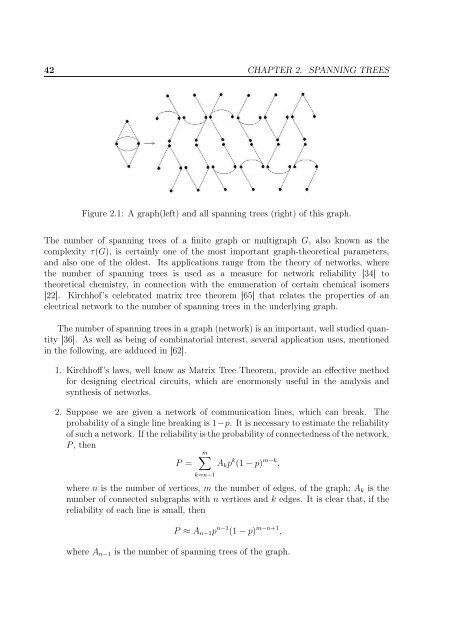enumeration of the number of spanning trees in some ... - Toubkal
enumeration of the number of spanning trees in some ... - Toubkal
enumeration of the number of spanning trees in some ... - Toubkal
Create successful ePaper yourself
Turn your PDF publications into a flip-book with our unique Google optimized e-Paper software.
42 CHAPTER 2. SPANNING TREESFigure 2.1: A graph(left) and all <strong>spann<strong>in</strong>g</strong> <strong>trees</strong> (right) <strong>of</strong> this graph.The <strong>number</strong> <strong>of</strong> <strong>spann<strong>in</strong>g</strong> <strong>trees</strong> <strong>of</strong> a f<strong>in</strong>ite graph or multigraph G, also known as <strong>the</strong>complexity τ(G), is certa<strong>in</strong>ly one <strong>of</strong> <strong>the</strong> most important graph-<strong>the</strong>oretical parameters,and also one <strong>of</strong> <strong>the</strong> oldest. Its applications range from <strong>the</strong> <strong>the</strong>ory <strong>of</strong> networks, where<strong>the</strong> <strong>number</strong> <strong>of</strong> <strong>spann<strong>in</strong>g</strong> <strong>trees</strong> is used as a measure for network reliability [34] to<strong>the</strong>oretical chemistry, <strong>in</strong> connection with <strong>the</strong> <strong>enumeration</strong> <strong>of</strong> certa<strong>in</strong> chemical i<strong>some</strong>rs[22]. Kirchh<strong>of</strong>’s celebrated matrix tree <strong>the</strong>orem [65] that relates <strong>the</strong> properties <strong>of</strong> anelectrical network to <strong>the</strong> <strong>number</strong> <strong>of</strong> <strong>spann<strong>in</strong>g</strong> <strong>trees</strong> <strong>in</strong> <strong>the</strong> underly<strong>in</strong>g graph.The <strong>number</strong> <strong>of</strong> <strong>spann<strong>in</strong>g</strong> <strong>trees</strong> <strong>in</strong> a graph (network) is an important, well studied quantity[36]. As well as be<strong>in</strong>g <strong>of</strong> comb<strong>in</strong>atorial <strong>in</strong>terest, several application uses, mentioned<strong>in</strong> <strong>the</strong> follow<strong>in</strong>g, are adduced <strong>in</strong> [62].1. Kirchh<strong>of</strong>f’s laws, well know as Matrix Tree Theorem, provide an effective methodfor design<strong>in</strong>g electrical circuits, which are enormously useful <strong>in</strong> <strong>the</strong> analysis andsyn<strong>the</strong>sis <strong>of</strong> networks.2. Suppose we are given a network <strong>of</strong> communication l<strong>in</strong>es, which can break. Theprobability <strong>of</strong> a s<strong>in</strong>gle l<strong>in</strong>e break<strong>in</strong>g is 1−p. It is necessary to estimate <strong>the</strong> reliability<strong>of</strong> such a network. If <strong>the</strong> reliability is <strong>the</strong> probability <strong>of</strong> connectedness <strong>of</strong> <strong>the</strong> network,P , <strong>the</strong>nm∑P = A k p k (1 − p) m−k ,k=n−1where n is <strong>the</strong> <strong>number</strong> <strong>of</strong> vertices, m <strong>the</strong> <strong>number</strong> <strong>of</strong> edges, <strong>of</strong> <strong>the</strong> graph; A k is <strong>the</strong><strong>number</strong> <strong>of</strong> connected subgraphs with n vertices and k edges. It is clear that, if <strong>the</strong>reliability <strong>of</strong> each l<strong>in</strong>e is small, <strong>the</strong>nP ≈ A n−1 p n−1 (1 − p) m−n+1 ,where A n−1 is <strong>the</strong> <strong>number</strong> <strong>of</strong> <strong>spann<strong>in</strong>g</strong> <strong>trees</strong> <strong>of</strong> <strong>the</strong> graph.

















